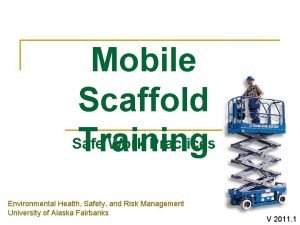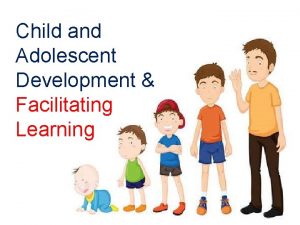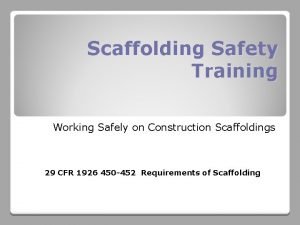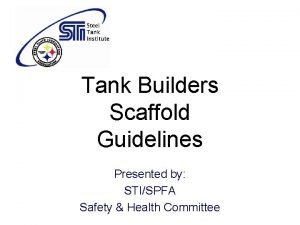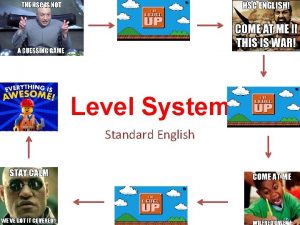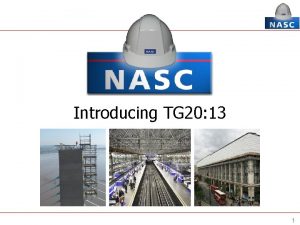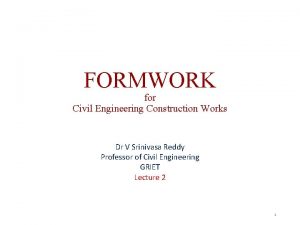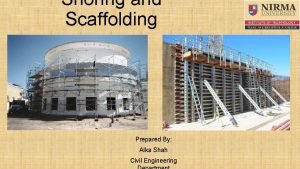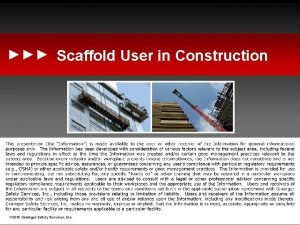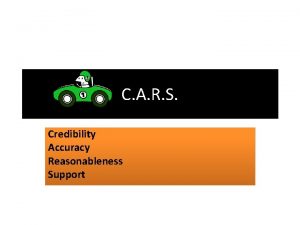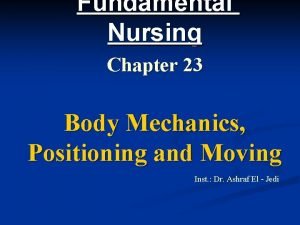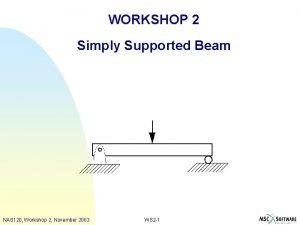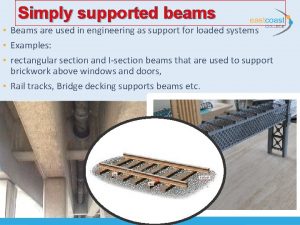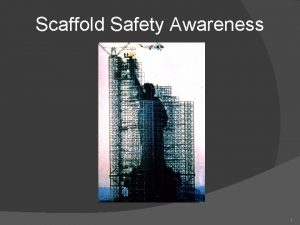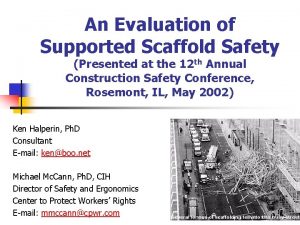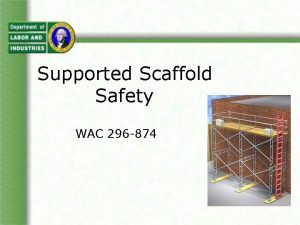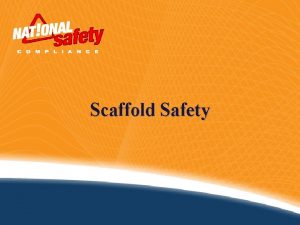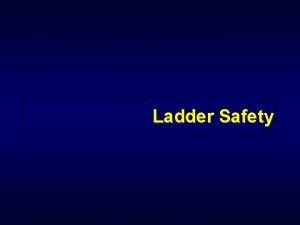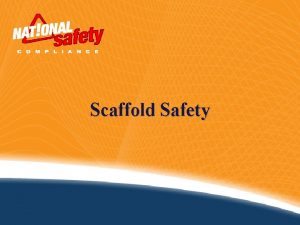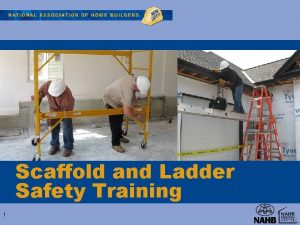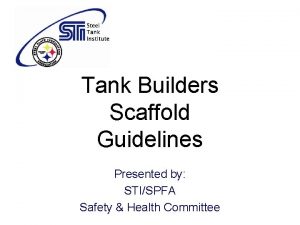Supported Scaffold Safety An Overview of Scaffold Safety

































- Slides: 33

Supported Scaffold Safety An Overview of Scaffold Safety November, 2019

Topics Covered Scaffold hazards Duties of a “competent person” Basic scaffold requirements Fall protection and guardrails Employee training Washington State Department of Labor & Industries 2

Supported Scaffolds Examples Fabricated frame scaffold Ladder jack scaffold Mobile scaffold Supported scaffolds are scaffolds that are in contact with the ground rather than being suspended by cables. Washington State Department of Labor & Industries 3

More Supported Scaffold Examples Washington State Department of Labor & Industries 4

Hazards of Scaffold Work According to the scaffold industry association, the five most serious scaffold hazards are: Falls Unsafe access Falling objects Electrocution Scaffold collapse Falls, scaffold collapse and electrocution account for most scaffold related fatalities. A combination of regular inspection and consistent training of workers can go a long way to reducing these risks. Washington State Department of Labor & Industries 5

Scaffold Collapse Can Happen The safety of a scaffold is highly dependent upon being built right in the first place. When scaffolds fail, they fail in a catastrophic way and can cause many serious injuries or deaths depending on who is on or around it when it fails. Washington State Department of Labor & Industries 6

Damage Scaffold Parts Damaged or weakened parts must immediately be: • Repaired, replaced, braced to meet minimum strength OR • Removed from service until repaired. Washington State Department of Labor & Industries 7

Erecting, moving, altering or dismantling scaffolds Must be supervised and directed by a competent person Must be done by trained employees selected by a competent person Washington State Department of Labor & Industries 8

What is a “Competent Person”? A competent person is able to: • Identify existing and predictable hazards, • Identify working conditions that are unsanitary, hazardous or dangerous and: • Has authority to eliminate hazards. A competent person must: • Have knowledge of what the scaffolding standard requires for workplace safety training and experience in erecting and inspecting scaffolds, • know about the kinds of hazards that can exist around scaffolds, • be designated by management as the competent person, • have authority to take action to stop unsafe activities and eliminate hazards identified. Washington State Department of Labor & Industries 9

Erecting and Dismantling Scaffolds While scaffolding is being erected or dismantled: A “competent person” determines feasibility of fall protection, and the employer must provide the maximum feasible fall protection. Questions to ask are: Is there a nearby structure from which a lifeline can be dropped that the worker can tie off to? Can we install guardrails immediately after installing the fabricated frames and before moving to the next level? Can we sequence disassembly to keep the worker protected for the maximum feasible time? Whatever is feasible to do must be done during the assembly/ disassembly stages. Washington State Department of Labor & Industries 10

Fall Protection on Scaffold Employers must provide fall protection on a scaffold more than 10 feet above a lower level by one of these methods: – Guardrails, which must be: o Installed along open sides and ends and o In place before employees use the scaffold OR – Personal fall arrest system o In accordance with WAC 296 -155 Part C-1 and WAC 880 - 30030. Must be attached to the structure or a lifeline and not the scaffold Washington State Department of Labor & Industries 11

Examples of Lack of Fall Protection Washington State Department of Labor & Industries 12

Requirements for Guardrails • Guardrails consist of toprail, midrail and falling object protection, such as a toeboard • The toprail must be between 38” – 45” high and withstand a 200 lb. force • The midrail must be installed midway between the top edge and the platform surface and withstand a 150 lb. force • A toeboard, when used, must be 3 ½ inches tall and able to withstand a 50 lb. force. Barricades at base of scaffold can be substituted for toeboard Washington State Department of Labor & Industries 13

Guardrails Cross bracing or “X” brace can substitute for top rail or mid rail but not both. Cross bracing is acceptable in place of a midrail when the crossing point of two braces is between 20 inches and 30 inches above the work platform. Cross bracing can be used as a top rail when the crossing point is between 38 inches and 48 inches above the work platform. The end points at each upright must be no more than 48 inches apart. Washington State Department of Labor & Industries 14

Provide a Ladder, Ramp or Direct Access For platforms more than two above or below a point of access In the picture on right, the worker is climbing the scaffold frame, which is in violation of the rule. Washington State Department of Labor & Industries 15

Power Line Clearance Insulated power lines Uninsulated power lines Less than 300 volts – 3 feet Less than 300 volts – 10 feet - 300 volts – 50 kilovolts = 10 feet - Over 50 k Volts, add. 4” per KV Examples of scaffolds too close to power lines You can get closer than these distances if you contact the power company and they deenergize the lines and visibly ground them or install protective shields. Washington State Department of Labor & Industries 16

Footings Support the load without settling or displacement ü Level ü Sound ü Rigid A mud sill isn’t needed on a concrete surface or dry compacted soil. You always need the base plate. Washington State Department of Labor & Industries 17

Unstable Footing Examples Cardboard, sticks, blocks, rocks or bricks aren’t a sound method of leveling Washington State Department of Labor & Industries 18

Platform Specifications • Each working level fully planked; no more than 1” gaps • Minimum platform and walkway width of 18” • Overlap planks between scaffold sections by at least 12” • Extend over support 6” min. (Maximum end extension 12”) • Don’t paint planks since they will hide defects • Front edge within 14” of the work, or guard rails or fall protection must be used. Washington State Department of Labor & Industries 19

Examples of Improper Scaffold Planking Scaffold platforms must be fully planked with no gaps greater than one inch. (and this employee needs fall protection) Gaps too wide between planks Washington State Department of Labor & Industries 20

Planks can’t extend more than 18” beyond their support If it’s not adequately secured, it can tip if you walk out past the support. If a plank extends too far past the support because it’s too long, you can barricade access to the hazardous area. Washington State Department of Labor & Industries 21

Plank Specifications • Scaffold grade or equivalent – 1, 500 lb-f/in 2 (stress grade) construction lumber – Manufactured planks used according to manufacturer’s recommendations Washington State Department of Labor & Industries 22

Wood Plank Inspection Damaged wood planks include: Rot - "squishy" feel, or powdery appearance from termite damage Cupping of 3/8" or more on a 10" wide or 1/2" or more on 12" wide plank. Crook of more than 5/16”, bow of more than 7/16” or twist of more than ¾” on a 10’ long 10” board. Wane of more than ¼ the width and ¼ the thickness for more than ¼ the length of the plank. A split that has a length of 1 ½ times the board width or more. Knots that are more than 1 ½” diameter if loose or 2” diameter if tight on a 10” plank. A notch cut into a plank more than 1/3 the plank width. Any saw kerf cut across the plank weakens the plank by the depth of the cut. The problem may not be noticed if the plank is later laid with the cut side down. Washington State Department of Labor & Industries 23

Plank Load Capacity 4 times the intended load + scaffold weight Planks must not deflect more than 1/60 of span when loaded Washington State Department of Labor & Industries 24

Examples of Overloaded Scaffolds Washington State Department of Labor & Industries 25

Overlaps Angled plank is not on the bottom Not fully planked at transition No guardrail at transition On a corner, planks that don’t come in at a right angle to the support must be on the bottom and then overlapped by the planks that are at a right angle. Washington State Department of Labor & Industries 26

Example of Unstable Support Forklifts and front-end loaders are not designed by the manufacturer for such use. Washington State Department of Labor & Industries 27

Guying, Tying or Bracing If the ratio of height to base is more than 4: 1, then: Install guys every 26’ above this tie point for scaffolds more than 3’ wide. Install these guys at each end of the scaffold and space additional middle guys no more than 30’ apart. If you use a cantilevered work platform (outside the framework of the scaffold), then you must use some type of bracing such as tying or outriggers to prevent the scaffold from tipping. Washington State Department of Labor & Industries 28

Other Scaffold Use Rules Don’t • Move a scaffold when someone is on it. • Work on a scaffold covered with snow or ice. • Work on a scaffold during a storm or high winds. • Use boxes, barrels or a ladder on top of a scaffold to increase its height. Do clean up debris on platforms before it accumulates. Washington State Department of Labor & Industries 29

Unacceptable Scaffold Example • Shore or “lean to” • Also, a competent person must approve the use of dissimilar metals • Intermixed scaffold components must fit together without force and not effect the structural integrity of the scaffold. This is an example of a lean-to scaffold. In this picture, the workers have a shore scaffold on top of another shore scaffold. Access is unsafe both from above and below. The only thing holding this scaffold up is the DUMPSTER! Washington State Department of Labor & Industries 30

Worker Must Be Trained On: • Recognizing hazards of the type of scaffold they’ll be using • Understanding the procedures to control or minimize hazards • How to erect, maintain and disassemble the fall protection and falling object protection systems • Using the scaffold and handling materials on the scaffold • Maximum intended load and capacity • Other information as needed Employees need training so they don’t misuse the scaffold or do things that will cause it to lose its integrity, such as removing cross bracing so they can do their work. Training needs to be specific to the scaffold the workers will be using. Job-specific issues would include power line clearances, surface conditions. Washington State Department of Labor & Industries 31

Worker Must Be Retrained When: • You believe an employee lacks the skill or understanding to safely erect, use or dismantle a scaffold • If an employee's work is inadequate • If there is a change in any of the following that presents new hazards: – Worksite – Type of scaffold – Fall protection – Falling object protection – Other equipment Washington State Department of Labor & Industries 32

Additional Information DOSH Scaffolds Rules: WAC 296 -874, Scaffolds Scaffold Accident Video – A Life-Changing Moment OSHA – Scaffolding e. Tool CPWR – Scaffold Safety Hazard Alert Spanish Oregon OSHA – Supported Scaffolds in Construction Oregon OSHA – Scaffold Safety (Spanish) Washington State Department of Labor & Industries 33
 Lean-to scaffold
Lean-to scaffold Feature article scaffold
Feature article scaffold Mobile scaffold inspection requirements.
Mobile scaffold inspection requirements. When dishes remain on a table when you yank
When dishes remain on a table when you yank Child and adolescent development and facilitating learning
Child and adolescent development and facilitating learning Pump jack scaffold must be fitted with two
Pump jack scaffold must be fitted with two Tank builders scaffold
Tank builders scaffold Standard english essay
Standard english essay Tg20 compliance sheet template
Tg20 compliance sheet template Bioresorbable vascular scaffold
Bioresorbable vascular scaffold Business report conclusion example hsc
Business report conclusion example hsc A brick falls freely from a high scaffold
A brick falls freely from a high scaffold Why does dimmesdale go to the scaffold
Why does dimmesdale go to the scaffold Statue of liberty scaffold
Statue of liberty scaffold Txxxc writing model
Txxxc writing model Scaffold plank overhang
Scaffold plank overhang Scaffold competent person training ppt
Scaffold competent person training ppt Profase
Profase Sole plate scaffolding
Sole plate scaffolding Patented scaffolding images
Patented scaffolding images Drupal-composer/drupal-scaffold composer 2
Drupal-composer/drupal-scaffold composer 2 Scaffold trailer for sale
Scaffold trailer for sale Scaffold terminology
Scaffold terminology Bio time 7.0
Bio time 7.0 Matrix supported conglomerate
Matrix supported conglomerate The principal message of this cartoon is that standard oil
The principal message of this cartoon is that standard oil Computer supported collaborative learning
Computer supported collaborative learning Credibility accuracy reasonableness support
Credibility accuracy reasonableness support Sims position nursing
Sims position nursing Computer supported collaborative work
Computer supported collaborative work Members of the progressive movement generally supported
Members of the progressive movement generally supported Nas120
Nas120 Proudly supported by
Proudly supported by Where simply supported beam used
Where simply supported beam used


